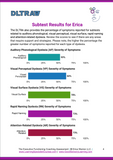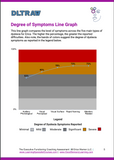Dyslexia Type Remedial Assessment | Comprehensive Report
Two Ways to Purchase - See Below
Unlock the true potential of your learners with dyslexia with my web-based assessment and comprehensive report.
What is the DysLexia Type Remedial Assessment (DLTRA) ?
The DLTRA (for ages 7+) provides a cost-effective and quick web-based assessment that generates customized reports to assist parents, educators, professionals, and schools to:
- rapidly assess the potential for a dyslexia diagnosis.
- define the specific type of dyslexia present.
- uncover specific remedial strategies.
- define teaching recommendations.
- provide suggestions for reasonable accommodations.
Features of the DTLRA:
- Comprehensive DysLexia Type Identification: The DTLRA specializes in determining the specific type of dyslexia, examining areas such as auditory phonological, visual perceptual, visual surface, rapid naming, and attention-related dyslexia.

-
Detailed Reports and Remedial Resources: Each assessment produces an in-depth report that includes visual data, detailed explanations, and links to remedial resources and suggestions to help guide the remediation process.
-
One-Time Purchase or Bulk Purchases: Buy a single assessment on this page, or for schools, organizations, and centers that want to buy multiple assessments, an online portal can provide advanced group analytics and data comparisons. This portal also allows for the bulk purchase of assessments and additional functionalities to support educational and therapeutic settings. Go to the bottom of the page for a sign-up link.
Additional Learning Resources:
For those seeking to deepen their understanding of dyslexia, the DLTRA offers a range of educational materials and teacher training resources to enhance knowledge and instructional practices.
Benefits of Using the DLTRA:
- Pinpoint Reading Challenges: By identifying one's specific type(s) of dyslexia, the DLTRA enables targeted intervention, making it easier for educators and therapists to tailor individual learning needs.
- Visual and Detailed Feedback: The visual reports and detailed feedback provided by the DLTRA help clarify the nature of the dyslexic challenges faced by individuals, facilitating a clearer path to improvement.
- Enhanced Group Insight: The partner portal's capabilities to assign reports and analyze data across groups can significantly benefit schools, practices, and centers.
Defining the Types of Dyslexia
- Auditory Phonological is characterized by difficulties in phonological processing, the ability to identify and manipulate the sounds of language. Individuals with phonological dyslexia often struggle with phonemic awareness (the understanding that words are composed of individual sounds) and have difficulty mapping sounds to letters, leading to challenges in spelling, accurate word pronunciation, decoding, and word recognition.
- Visual Perceptual Dyslexia refers to difficulties with visual processing and perception. These individuals may have challenges in a variety of visual processing areas, such as spatial, synthesis, and closure. Some may struggle to distinguish between similar-looking letters (e.g., b and d) or have difficulty maintaining focus on the text. They may also exhibit problems with visual tracking and visual memory. This can affect various aspects of reading, including letter recognition, word decoding, and comprehension.
- Visual Surface Dyslexia suggests difficulties in recognizing and recalling whole words by sight. Many struggle with irregularly spelled words that do not follow predictable phonetic rules. They may also rely more on phonetic decoding strategies rather than recognizing words as whole units. It involves word-level processing and typically leads to difficulties with reading fluency and accurate word recognition.
- Rapid Naming Dyslexia is characterized by difficulties in rapid automatic naming (RAN), which refers to the ability to quickly name familiar objects, colors, or symbols. Individuals with rapid naming deficit dyslexia may experience delays in retrieving and articulating verbal responses, which can also impact reading, writing, and speech fluency.
- Attention-Related Dyslexia must coincide with another type of dyslexia. It is associated with difficulties in sustaining attention and focusing during reading tasks. Many have trouble maintaining concentration, leading to reduced overall learning accuracy and comprehension. When learners only exhibit attentional dyslexia on this screener, they are not likely to have dyslexia. Instead, testing for attention problems should be pursued.
- Mixed Dyslexia is a combination of Auditory Phonological Dyslexia and Visual Perceptual Dyslexia. Mixed dyslexia results in challenges with decoding, word recognition, spelling, reading fluency, and visual-spatial tasks.
- Double Deficit Dyslexia is a combination of phonological dyslexia and rapid naming dyslexia. In double deficit dyslexia, individuals exhibit deficits in both of these areas, which can impact their reading fluency, decoding, and word recognition abilities.
- Acquired Dyslexia is the result of an illness or injury to the brain.
- Developmental Dyslexia is genetic and present from birth.
Visual Reports & Targeted Resources
- Clear and Comprehensive Reports: Receive detailed reports with analytics, explanations, strategies, and more.
- Actionable Resources: Access valuable resources for targeted remediation.

View a Sample Report
Purchase Options:

Single Purchase:
- Purchase the assessment by selecting the purchase button on this page.
- Take the assessment
- Receive an immediate, comprehensive report with analytics, remedial recommendations, as well as teaching and product recommendations.
- The test taker receives an email with a copy of the report. *Check Spam if it’s not in your inbox.
Partner Portal (multi-purchase): for Practitioners and Organizations:
Once you have created your partner portal, this is the sign-in link: https://drericawarren.brilliantassessments.com/
Follow the steps below to create a new partner portal:
- Create your partner portal by going to: https://drericawarren.brilliantassessments.com/Organizations/Initiate.
- Receive an email with your login setup. *Check Spam if it’s not in your inbox.
- In your portal, purchase discounted allotments of 5-1000 assessments.
- Allocate and share the assessment in the partner portal and complete the assessment.
- Receive an immediate, comprehensive report with analytics, remedial recommendations, as well as teaching and product suggestions.
- Test taker and administrator (optional) receive an email with a copy of the report. *Check Spam if it’s not in your inbox.
- Use your partner portal for data comparisons, purchasing assessments, and allocating credits.















